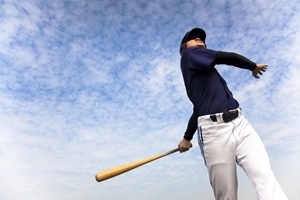Head's up to those working in physical therapy jobs: Spring is nearly here, which means fly balls are abundant and so are potential injuries. Baseball is a particularly popular sport, often regarded as America's pastime. In fact, according to a 2012 Gallup survey, 48 percent of respondents said they were a fan of the classic sport, which is the highest number in the questionnaire's history. From T-ball to little league and all the way up to the MLB, fans and players just can't resist the energy of the game. As such, health professionals will see athletes of all ages in their physical therapy clinics.
While baseball has little contact between players, it still puts athletes at risk for injury. According to STOP Sports Injuries, 45 percent of young baseball players between the ages of 13-14 will experience arm pain in a single season. For kids ages 8-12, that number is 20 percent. Of course, general pain isn't the only risk athletes face. PTs must be aware of common injuries so they can prepare for patients who play baseball in the upcoming months.
Meniscus tears
According to ESPN, meniscus tears are especially apparent in hitters, or players who swing a bat at pitched balls. Because the issue often requires surgical repair, many athletes opt to forgo treatment until the end of the season. This allows them to avoid sitting on the sidelines during an extensive recovery period. As such, PTs must be aware that when baseball players come in with knee injuries, the tear may have been worsened by lack of care.
To develop a recovery plan that best suits baseball players, it may be beneficial for PTs to understand the ways in which these athletes use their knees. While healthcare professionals may be familiar with the movements required for running the bases, the act of swinging a bat calls for unique mobility.
While it's true that every player has his or her own way of batting, individuals in the sport follow general concepts. According to Pro Baseball Insider, the foot, knee and hips should be aligned when the athlete swings the bat, and the back foot is raised up by the toes.
This video, which is part two of a series from Pro Baseball Insider, breaks down the proper technique, specifically noting the position of the knee. A meniscus tear can prevent baseball players from correctly following this form.
Muscle strains
Muscle strains are commonplace in baseball, no matter the player's position on the field. As ESPN explained, hitters are likely to experience muscle strains in the hamstrings and quadriceps from running the bases. However, the calf and oblique abdominals are not immune to this risk either. The latter of those two is particularly common in pitchers because they frequently rotate their torsos. A moderate strain can have pitchers on the bench for six to eight weeks, so recovery is critical for getting back in the game.
Muscle strains typically hold one of three rankings: mild, moderate or severe. PTs will likely only see baseball players when muscle strains have been diagnosed as severe. Beyond offering PT services, healthcare professionals should provide advice so baseball players can avoid these injuries in the future. Part of prevention involves effective warmups and proper stretching. During the appointment, have the patient show you his or her typical pre-game or practice routine so you can ensure the individual is using the right form.
Throwing injuries
There are several physical ailments specific to baseball pitchers because they spend so much time throwing the ball. According to Baseball-Reference, each team throws an average of 146 pitches per game, and coaches might only use four players for this position – sometimes less.
According to the American Academy of Orthopaedic Surgeons, this repetitive motion can contribute to a number of shoulder- and elbow-related ailments, including valgus extension overload, flexor tendonitis, ulnar collateral ligament injuries, ulnar neuritis and olecranon stress fractures.
For all of these injuries, provide tools and advice for baseball players to carry on the rehabilitation process both on and off the field. They'll need something to occupy their time while they wait for their injury to heal anyway. At-home instructions may encourage them to focus on recovery instead of jumping right back into the sport.

